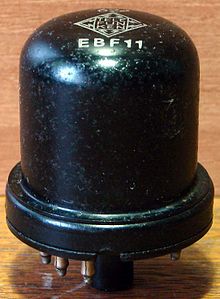Steel tube

A steel tube is an electron tube whose piston made of painted steel consists. In 1937 Telefunken launched a series of tubes with steel pistons. The first preliminary work on this can be dated back to 1917.
construction
The basic structure consists of a steel plate to which metallic supports for the horizontally constructed pipe system have been welded. For later contacting, Fernico , an alloy of iron , nickel and cobalt , with a coefficient of expansion that is favorable for glass melt-downs, were soldered into holes in the base plate. The system itself, which was produced separately, was then welded to the system carriers. Then the flask was put on.
One of the technological challenges was the resistance welding connection between the piston and the base plate. Electric currents of up to 180 kA were used here in order to obtain a vacuum-tight connection.
The remaining operations do not differ significantly from those for glass flask tubes.
Advantages and disadvantages
The advantages of this fundamentally new, pinch-footless construction were
- much shorter connections to the pipe system,
- an integrated shielding of the tube system against interference fields,
- lower mechanical sensitivity of the piston,
- as well as a more stable system structure due to its horizontal position with system stabilization on both sides on the base plate,
- simplified structure by dispensing with the grid cap connection and thus generally shorter connections in the receivers.
The suggestive effect of this steel tube (steel is stable and durable, glass fragile and fragile) was great enough that the RCA in the USA also tried to build steel tubes and presented them in the spring of 1935. The development was not yet completed at this point, 40% of the production was lost as scrap. This partially resulted in variants that were interesting from a marketing perspective; Tubes with the technically already mastered glass bulb, over which an aluminum bulb was slipped over for optical purposes and mechanically connected to the base .
The two-year delay in the German start of production compared to the USA paid off thanks to the higher quality of production right from the start. Output stage and rectifier tubes were not manufactured using steel piston technology as standard. Here, the domed piston still dominated the system structure because it was cheaper to manufacture, had better heat dissipation at higher outputs and the long connecting wires mentioned above did not play a role in terms of circuitry. Only for car radios and suitcase devices few power stage and rectifier tube types were as EDD11 and EZ11 made in the steel design in Germany.
In 1948, Telefunken Gesellschaft's Ulm tube works began building steel tube systems in glass flasks. They would have liked to have made steel tubes, but the necessary machines were destroyed during the war or dismantled as reparations. So - temporarily - bizarre glass tubes with steel bases and again a vertical system structure were produced. After the steel tube had been massively advertised as a German advance, it became difficult to make glass tubes palatable to customers again.
The tube works of the RFT subsequently also produced steel tubes with glass bulbs, but these were much closer to the original, as the basic system structure was retained in the horizontal.
With the advent of VHF / FM radio at the beginning of the 1950s, short cable runs became essential for good reception performance at the given frequencies around 100 MHz. While Philips / Valvo were already using the newly developed tubes of the Rimlock socket series in their own devices at the beginning of the 1950s , Telefunken retained the steel tubes for the time being. New tubes were even developed for VHF broadcasting; for example the EAA11 as a duo diode for the ratio detector circuit .
Ultimately, the steel tubes could not prevail: The large piston diameter due to the horizontal system structure noticeably restricted the progressive miniaturization of the devices. Higher manufacturing costs due to the separate base, insufficient gas tightness of the steel piston per se, insufficient electrode degassing during production (HF field does not penetrate the steel piston) were among other reasons for abandoning this design at the end of the 1940s.
An exception is the VF14, which was still in production until the end of the 1950s. It was mainly installed as a preamplifier tube in the NEUMANN U-47 and U-48 condenser microphones .
literature
- Ludwig Ratheiser: Radio tubes - properties and application . Union Deutsche Verlagsgesellschaft, Berlin 1936.
- Herbert G. Mende: Radio tubes, how they became, what they do, and other things that are not in Barkhausen . Franzis-Verlag, Munich 1966.
Individual evidence
- ↑ Patent DE329231 : Vacuum vibration generator or amplifier. Published on December 30, 1917 , inventor: Erich F. Huth.
- ↑ Radio technology 1948
